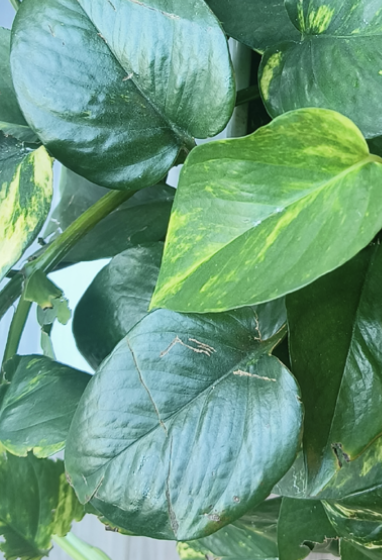The visible pollution may appear to come from outside the windows of our homes, but recent studies have revealed that the very walls we live within are significant sources of indoor air pollutants. Basic activities like cooking, cleaning, painting, and washing emit various pollutants. Although air purifiers and filters are available, they are often beyond the reach of the average person. Therefore, for sustainable management of this issue, certain indoor plants have the natural ability to purify indoor air through a process called phytoremediation.
Indoor air quality can be significantly impacted by external pollution, as seen in Delhi (figure 1), where the AQI is 180 indoors despite an outdoor AQI of 300. Factors like outdoor air infiltration, poor ventilation, and indoor pollutants such as dust, cooking fumes, and chemicals contribute to this. Similarly, in Riyadh, while outdoor air quality is unhealthy at 180, indoor air quality of 100 still poses a moderate risk. These conditions show that even indoors, the air can be polluted, affecting health, especially for sensitive groups.
Figure 1 – Comparison of Indoor and Outdoor AQI in Various Regions (based on WHO Study)
These plants produce excess oxygen improving air quality and psychological well-being for people living and working in crowded places. They also absorb other organic air pollutants such as xylene, toluene, and formaldehyde released from cleaning agents, furniture, and air conditioners, converting them into non-toxic substances and releasing oxygen as a by-product with help of phytoremediation.
Plants, often underappreciated for their role in our indoor environments, possess an inherent capacity to purify the air we breathe. Through a process known as phytoremediation, certain indoor plants have the remarkable ability to cleanse the air by absorbing and neutralizing pollutants emitted from everyday activities such as cooking, cleaning, and using household products.
Phytoremediation is an environmental restoration mechanism that utilizes plants and their associated microorganisms to reduce the toxic effects of contaminants in the environment. It is also a sustainable approach to environmental cleanup that leverage the natural abilities of plants to mitigate pollution. The process involves plants absorbing, degrading, or sequestering pollutants from the environment.
By strategically incorporating specific plant species (table 1) into our indoor spaces, we can actively combat the pollutants that compromise our air quality. Not only do these plants act as natural air purifiers, but they also contribute to cooling the surrounding environment and play a significant role in removing suspended particulate matter, effectively enhancing the overall air quality.
Table 1: Common plants to improve indoor air quality
| No. | Common Name | Scientific Name | Targeted Pollutants |
| 1 | Aloe Vera | Aloe Vera | Benzene, Formaldehyde, Carbon dioxide, Carbon monoxide |
| 2 | Bamboo Palms | Chamaedorea seifrizii | Formaldehyde, Benzene, Carbon monoxide, Xylene, Chloroform |
| 3 | Spider Plant | Chlorophytum comosum | Benzene, Formaldehyde, Carbon monoxide, Xylene |
| 4 | Snake Plant | Sansevieri atrifasciata | Formaldehyde, Trichloroethylene, Xylene, Toluene, Benzene; also absorbs carbon dioxide |
| 5 | Money Plant | Epiprem numaureum | Formaldehyde, Xylene, Toluene, Benzene, Carbon monoxide |
| 6 | Janet Craig | Dracaena deremensis | Formaldehyde, Xylene, Toluene, Benzene, Trichloroethylene |
| 7 | Lady Palm | Rhapis excels | Carbon monoxide, Formaldehyde, Benzene, Toluene |
| 8 | Rubber Plant | Ficus robusta | Carbon monoxide, Formaldehyde, Trichloroethylene |
| 9 | Dragon Tree | Dracaena marginata | Xylene, Trichloroethylene, Toluene |
| 10 | Areca Palm | Dypsis lutescens | Xylene, Toluene |
Plants are the fundamental oxygen pumps responsible for our survival and have special features to combat pollutants (partly due to the symbiotic relationship with beneficial root zone microbes) produced within our homes. Plants also produce positive results in offices, which are often enclosed with air conditioners. Moreover, these indoor plants require minimal maintenance and light, making them ideal for both conscientious gardeners and busy individuals.
Therefore, it is imperative to encourage this economic and low-cost approach in both homes and workplaces to transform pollutants into harmless by-products as well as releasing oxygen into the environment.
About the author:
Name: Dr. Hishmi Jamil Husain
Dr. Hishmi Jamil Husain is a renowned sustainability leader, serving as Lead Strategy Market & Analyst at Aramco with an impressive educational background and numerous accolades, including the Young Scientist Award and Lifetime Achievement Sustainability Excellence Award, he is a prominent figure in global conservation efforts. As an author of two books and numerous articles, his thought leadership covers critical topics such as nature-based solutions and climate change mitigation continue to inspire positive change on a global scale. With international experience across 13 countries, Dr. Hishmi’s vision and expertise continue to shape sustainable practices worldwide.

